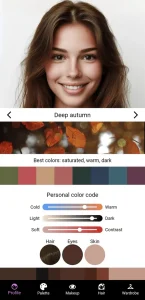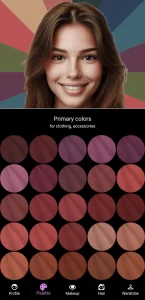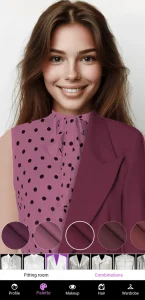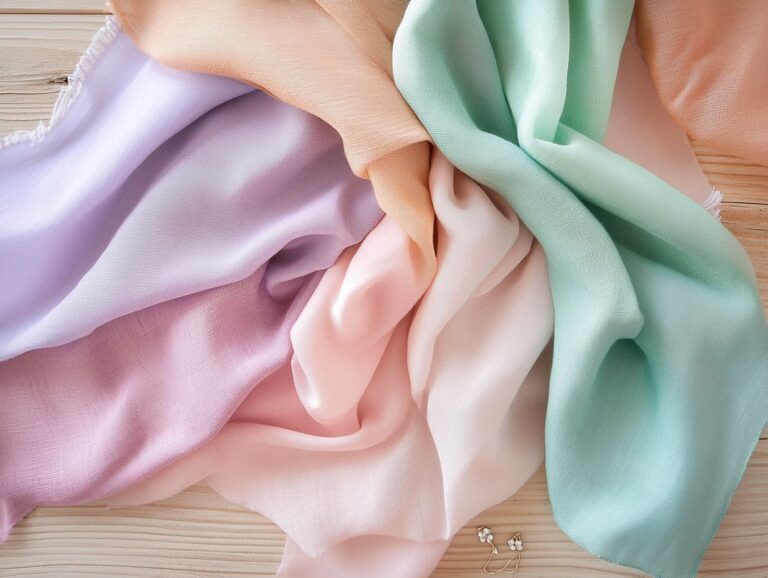**The Basics of Hair Color Guide**
The world of hair color can be both exciting and overwhelming, whether you’re looking to enhance your natural hues or make a significant transformation. This guide covers the fundamentals of hair color, including the factors that influence your hair’s color, tips for choosing a hair color that complements your skin tone, and a comparison of the pros and cons of DIY versus professional coloring. Additionally, it provides guidance on how to prepare for hair coloring and offers maintenance tips to help keep your hair looking its best.
Understanding Your Hair Color
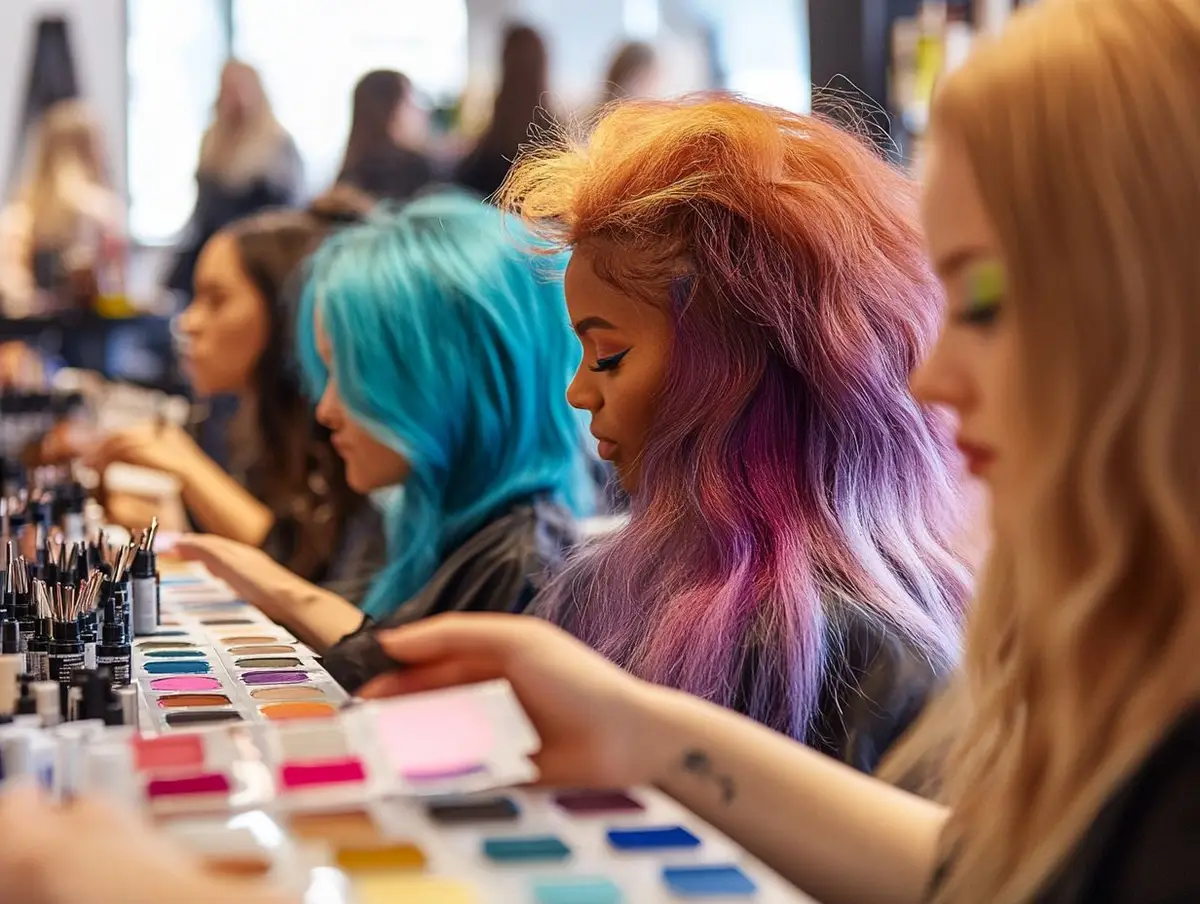
Understanding hair color is essential as it enables you to achieve a flattering and vibrant hue that complements your unique features, such as your skin tone, eye color, and personal style. By mastering techniques like balayage and ombre, you can further enhance your look.
By grasping the basics of hair color, including the distinctions between warm, cool, and neutral undertones, you can select the right shades and techniques—such as balayage and ombre—that enhance your natural beauty and reflect your individuality. Incorporating color enhancing treatments can result in a youthful look.
Hair Color Basics
Understanding hair color basics involves recognizing the three primary undertones that influence the selection of any shade: warm, cool, and neutral undertones.
Warm undertones are characterized by yellow, gold, or peach hues in the complexion. As a result, individuals with warm undertones typically gravitate toward golden blonde shades, rich brown, and warm browns like copper auburn.
Cool undertones, on the other hand, feature pink, red, or blue hues in the skin. Those with cool undertones often prefer ashy blonde shades, icy platinum, and deep cool browns.
Neutral undertones fall between the warm and cool categories, allowing individuals to wear a broader range of colors without the concern of clashing.
To enhance an individual’s overall skin tone and achieve a balanced look, it is essential to choose a hair color that aligns with their undertones. Doing so will lead to the most natural-looking hair colors for that person, creating a dream hair appearance.
Factors that Affect Hair Color and Trends
Several factors influence hair color choice and the resulting shade, including hair type, hair texture, and eye color. Additionally, staying updated with hair color trends can influence your choices. These elements play a crucial role in determining the final outcome when dyeing hair.
- Hair Type: Understanding your specific hair type—whether it is straight, wavy, curly, or coily—can provide insight into how well certain colors will adhere to your hair and how they will appear.
- Hair Texture: Finer hair often feels more delicate with pastel shades, while thicker strands hold deep, bold colors more effectively. Additionally, the texture of the hair can impact how light reflects off of it, affecting the vibrancy of the color in natural light. Using color maintenance products can help preserve this vibrancy.
- Eye Color: Principles of seasonal color analysis can assist individuals in selecting colors that complement their skin tone and undertones. This understanding helps in choosing hair colors that enhance their overall features rather than clash with them.
Choosing the Right Hair Color to Achieve Your Perfect Shade
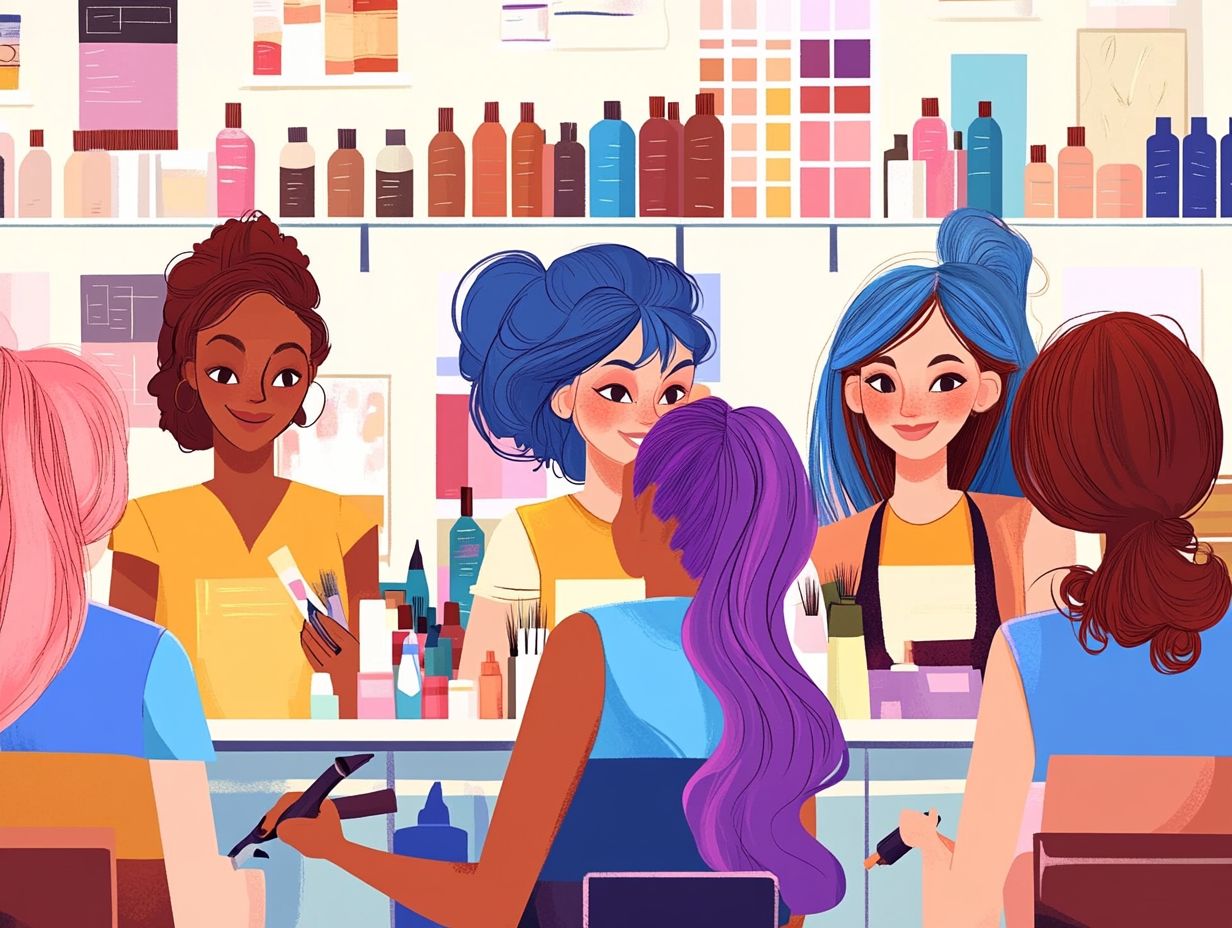
Selecting the right hair color is a thoughtful process that involves considering factors such as skin tone, personal preference, and the desired outcome.
These elements are essential for choosing a hair color that complements your natural beauty and boosts your confidence. Consulting with a professional stylist can help you find your perfect shade.
A personalized consultation with a professional stylist is crucial for navigating the wide array of hair color options available and finding the custom shade that is perfect for you.
Matching Your Skin Tone
Matching hair color to skin tone is essential for ensuring that the two complement each other and enhance the person’s features. When selecting a hair color shade, it is important to understand the differences among the three main skin tone categories: warm, cool, and neutral. A consultation process can help in this selection and boost confidence.
Warm tones, characterized by a golden or peachy base, look best in rich shades with golden undertones, such as:
- honey blonde
- golden brown
- rich caramel
- warm chestnut
- reddish hues
In contrast, cool tones, which have pink, red, or blue base colors, are more flattering in shades with an ashy base, such as:
- ash blonde
- platinum blonde
- deep plum colors
- chocolate brown
Neutral skin tones, featuring a balanced mix of warm and cool undertones, suit shades that incorporate both, such as:
- soft brown
- neutral blonde
- walnut brown
A hair color chart serves as a helpful visual reference for individuals seeking to identify which shades are most complementary to their complexion.
Complementing Your Natural Hair Color
Complementary shades that enhance your natural hair color can create a beautiful transition, highlighting both your natural beauty and your personal artistic expression. Utilizing subtle highlights can add dimension and vibrancy to your look.
By utilizing highlights, lowlights, and trendy colors, you can enhance the richness and body of your hair’s natural pigment. Selecting the right shades that align with your natural hair color makes it easy to brighten up a shade or add depth to it.
Well-known hair dye brands like Olaplex and Wella have developed products that not only cater to current trends but also offer age-appropriate color options. Highlights bring brightness and shine, while lowlights add shadow and depth, ensuring that the final look is both modern and timeless.
DIY vs Professional Hair Coloring
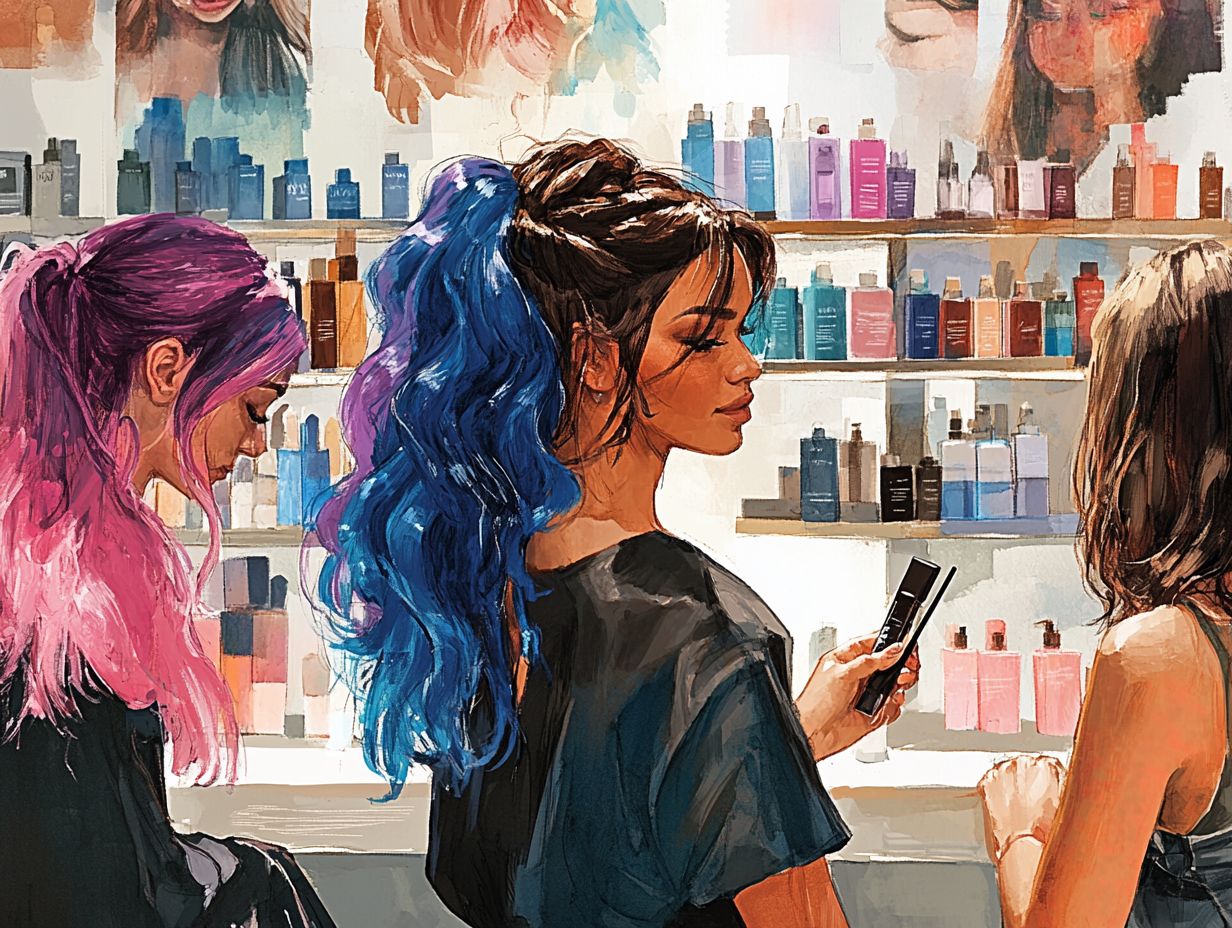
It is essential to consider the pros and cons of DIY versus professional hair coloring, as both approaches offer distinct benefits and challenges that ultimately affect the final results and the health of your hair.
Pros and Cons of Each Option
The advantages and disadvantages of DIY hair coloring versus professional services can significantly impact your overall experience and satisfaction throughout your hair color journey, ultimately influencing your confidence and hair health in meaningful ways.
Opting for a DIY approach often offers flexibility, allowing individuals to color their hair at home whenever they choose and providing significant cost savings compared to salon prices.
However, without the guidance of a professional, mistakes can result in uneven color or damaged hair, highlighting the importance of using proper hair care products for color maintenance.
In contrast, professional hair coloring offers the expertise of a trained stylist, who can customize the color to match individual skin tones and preferences, resulting in a more polished finish.
The downside to this option, however, can be the expense and time commitment associated with regular salon visits, which may not be feasible for everyone.
Recognizing these trade-offs can help you make an informed decision regarding your hair color choices.
Preparing for Hair Coloring
Preparing for hair coloring is essential as it enhances the condition of the hair, allowing it to absorb color more effectively, ensuring that the color lasts longer, and making it look more vibrant.
Tips for Prepping Your Hair
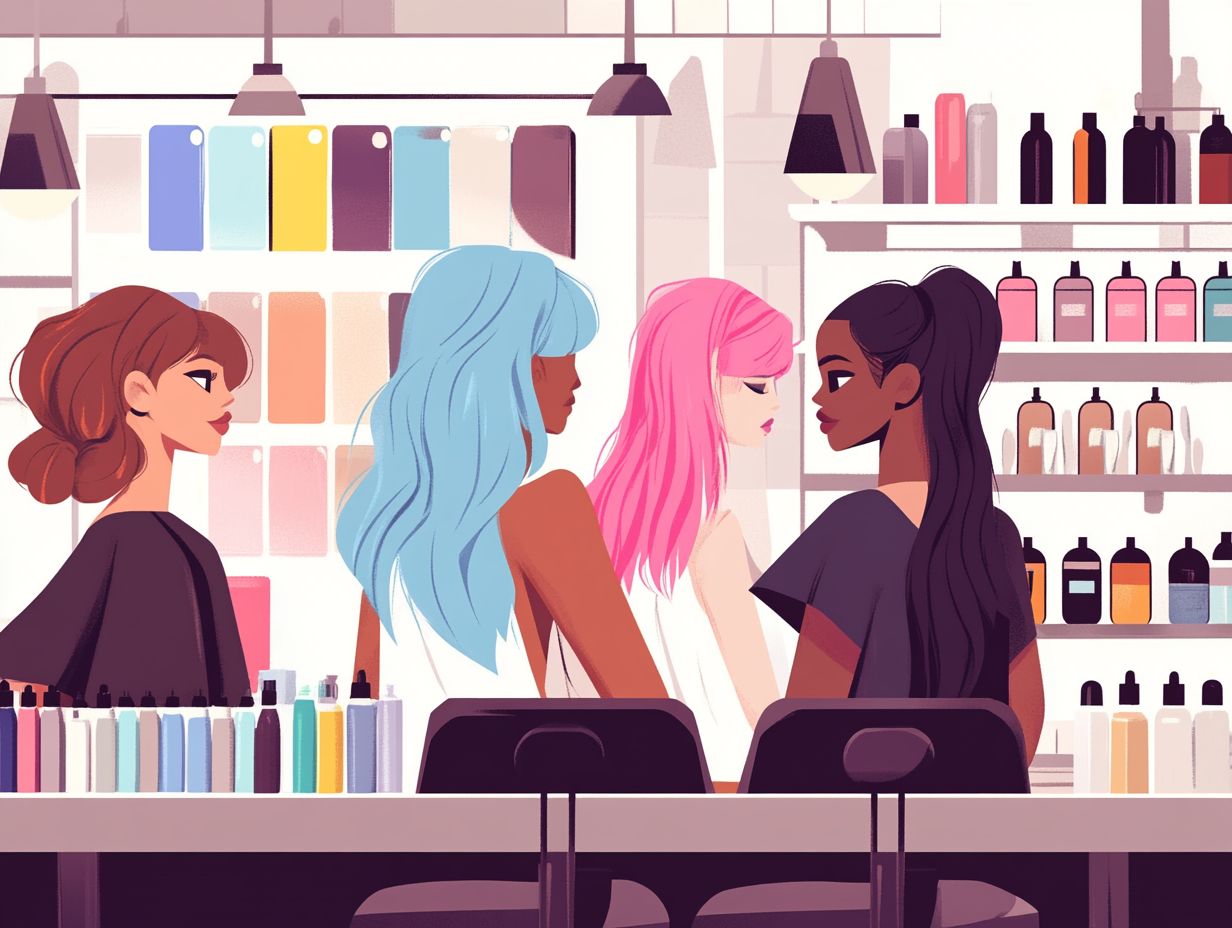
To ensure the health and vibrancy of your hair after coloring, consider the following tips for preparation that will help you achieve optimal results:
- Choose the right hair products for your specific hair type: Different hair types, whether curly, straight, or previously colored, require tailored products for proper preparation.
- Use a deep conditioning treatment a few days before coloring: Deep conditioning treatments add moisture and elasticity to the hair, reducing the risk of damage during the coloring process.
- Avoid styling products on the day of coloring: Refraining from using hair gels, sprays, and other styling products on the day of coloring allows the dye to penetrate the hair more effectively, resulting in a richer color.
By following these steps and using quality hair care products, you’ll provide the best foundation for your new color while helping to protect your hair.
What to Expect During the Process
Hair coloring involves a consultation, the application of color, and post-coloring care, all aimed at enhancing the health and appearance of the hair. The process begins with a consultation to discuss the client’s hair type, texture, and any previous color treatments in order to determine the most suitable shade. This helps ensure that the selected color complements their personal style and desired vibrant look.
This step also includes a conversation between the stylist and the client to understand the client’s stylistic preferences and desired outcomes.
Following the consultation, the chosen color is applied using various techniques, such as balayage or foiling. The application is performed carefully to ensure even distribution of the dye while minimizing damage to the hair strands. This careful approach is key to achieving a flattering hair color.
Once the dye has set, the professional washes and conditions the hair using specialized products designed to prevent color fading.
Finally, aftercare is discussed, providing the client with maintenance tips, including the use of professional settings and recommended products to use at home to prolong the vibrancy of their new color.
Maintaining Your Hair Color
Maintaining hair color is essential for preserving the vibrancy of dyed hair and ensuring its continued health and beauty. Utilizing both permanent and temporary hair dye options can offer flexibility in color maintenance.
Proper maintenance involves a dedicated routine that includes using appropriate hair care products and scheduling regular touch-ups.
Proper Hair Care Techniques
Effective hair care techniques are essential for maintaining hair color and can help protect its vibrancy and health for an extended period. Following proper color maintenance practices can result in a long-lasting, vibrant look.
To achieve the best results, it is important to use a sulfate-free shampoo that cleanses without stripping away natural oils and color. Incorporating deep conditioning treatments is also vital, as they provide essential moisture and nutrients, preventing dryness, color fade, and promoting overall hair health. Using the right hair care products, such as those tailored to your hair type and texture, can make a significant difference in the vibrancy of your hair color.
Additionally, color-enhancing treatments are necessary to enrich the color and strengthen the hair’s structure, ensuring a longer lifespan and shine. These treatments can be particularly effective when using quality hair dye brands, whether you’re aiming for a golden blonde, rich brown, copper auburn, ashy blonde, or icy platinum look.
By following these methods, anyone can enjoy vibrant hair while promoting overall health and resilience, transforming every head into a masterpiece. Whether opting for subtle highlights, deep cool browns, or vibrant colors, choosing the right products and techniques, like balayage or ombre, can enhance personal style and confidence.
Touch-Up, Balayage, Ombre, and Maintenance Schedule
A proper touch-up and maintenance schedule is essential for ensuring the longevity of your hair color, keeping up with trends, and achieving a youthful look.
If your hair grows at a typical rate and you are using a trendy shade or a more natural tone, touch-ups every four to six weeks should be sufficient. For techniques like balayage or ombre, touch-ups can be extended to every eight to twelve weeks, as these styles tend to grow out more naturally. Consulting about your perfect shade in between touch-ups can help maintain a flattering hair color that suits your eye color and skin tone, whether you have warm undertones, cool undertones, or neutral undertones.
Consulting a professional stylist is crucial, as they can assess the health and growth of your hair, helping to create a maintenance schedule that fits your lifestyle and preferences. They can guide you on the consultation process, seasonal color analysis, hair color trends, and choosing age-appropriate colors for a youthful look. A professional stylist will also help in selecting the right hair dye, whether you need permanent hair dye or temporary hair dye, and provide expert maintenance tips.
They will not only assist in maintaining the vibrancy of your chosen color, using highlights and lowlights if necessary, but also ensure minimal damage to your hair. This professional guidance aids in overall hair health and helps achieve your dream hair, boosting your confidence.




